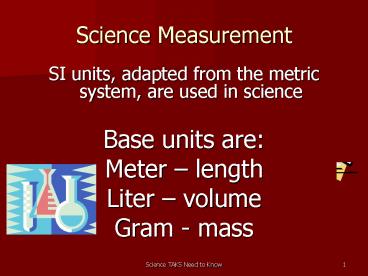Science Measurement - PowerPoint PPT Presentation
1 / 28
Title:
Science Measurement
Description:
Different types of graphs are used to show different relationships ... Anemometer. A weather instrument used to measure wind speed. Science TAKS Need to Know ... – PowerPoint PPT presentation
Number of Views:43
Avg rating:3.0/5.0
Title: Science Measurement
1
Science Measurement
- SI units, adapted from the metric system, are
used in science - Base units are
- Meter length
- Liter volume
- Gram - mass
2
Types of Graphs - LINE
- Different types of graphs are used to show
different relationships between data - Line graphs show continuous change
Quantitiy
3
Types of Graphs - BAR
- Different types of graphs are used to show
different relationships between data - Bar graphs compare two measured variables (show
differences)
4
Types of Graphs- PIE
- Different types of graphs are used to show
different relationships between data - Pie graphs show percentages
5
Democritus named the atom
- 2,500 years ago, the Greek philosopher
Democritus, decided that matter was made up of
tiny, indivisible units called atoms.
8.3E
6
Spring Scale
- Measure WEIGHT in Newtons
7
Graduated Cylinder and Beaker
- Both measure volume in mL, but the graduated
cylinder is more precise.
8
Meniscus
- "A characteristic of liquids in glass containers
is that they curve at the edges. This curvature
is called the meniscus. You measure the level at
the horizontal center or inside part of the
meniscus. With water in glass, the meniscus will
curve up at the edges and down in the center.
Always read the bottom of the meniscus."
9
Triple Beam Balance
- Measures MASS in GRAMS
- Always carry this with 2 hands!
10
Microscope
- Calculate total magnification by multiplying the
power of the eye lens X the power of the
objective lens
11
Goggles
- Protective plastic goggles are worn during
experiments to keep your eyes safe.
12
Telescope
- Used to view far away objects, like stars and
planets. - Contains lenses or mirrors to magnify distant
objects.
13
Test Tube
- A glass tube used to hold or heat substances.
Never point the open end of a test tube at
anyone!
14
Hot plate
- An electrical plate used to heat substances in a
lab investigation. Always protect yourself!
15
Meter Stick
- A ruler marked in millimeters, centimeters
meters used to measure length.
16
Petri Dish
- A round, flat dish with a cover that is used to
grow microorganisms in the lab.
17
Thermometer
- Measures temperature in degrees Celsius (oC)
18
Anemometer
- A weather instrument used to measure wind speed.
19
Barometer
- Weather instrument that measures atmospheric
pressure. Changes in barometric pressure usually
indicate a change in weather.
20
Dissecting Equipment
- Equipment such as a scalpel, forceps
dissecting probe used to cut open and examine
preserved specimens or to take apart a flower.
21
Independent Variable
- The MANIPULATED or CHANGED factor in an
experiment. This is the variable controlled by
the person doing the experiment. - Ex You may change the amount of water you give
a plant or the amount of fertilizer applied to
soil.
22
Dependent Variable
- The outcome or RESULT of manipulating or changing
the independent variable. - What happens to the dependent variable is the
EFFECT of what the experimenter does to the
independent variable
23
Inferences
- Conclusions that go beyond the facts
24
Promotional Claim
- A statement used to sell a product or service.
Can sometimes be misleading, so you need to
understand basic science facts to be able to
evaluate how valid the information is.
25
Valid conclusion
- Valid results are those that are well-supported
by evidence. When scientific findings are
evaluated, a scientist looks for reliable and
accuracy. Multiple trials, or sets of data, give
us more reliable and valid information. - VALID results are REPRODUCIBLE they can be
recreated by other scientists.
26
Topographic map (Contour map)
- Special kind of map that shows the height or
elevation of land areas.
27
Contour lines intervals
- Contour lines
- Lines that represent equal elevation
- Contour intervals
- The space between the contour lines- The smaller
the space (closer the lines) the steeper the
slope.
28
Models
- A diagram or an object that represents something
else demonstrates how it works. - Models arent exactly the same as what they
represent so they have limitations and can always
be improved. - Questions to ask about models-
- How closely does it resemble what it represents?
- What does the model show?
- How might the model be improved?






























